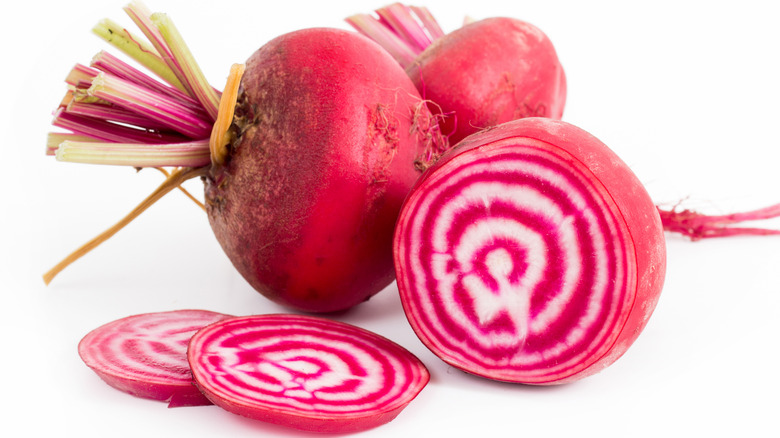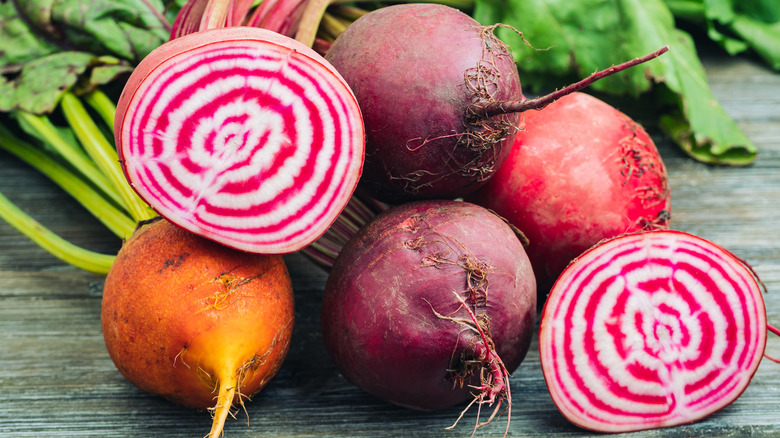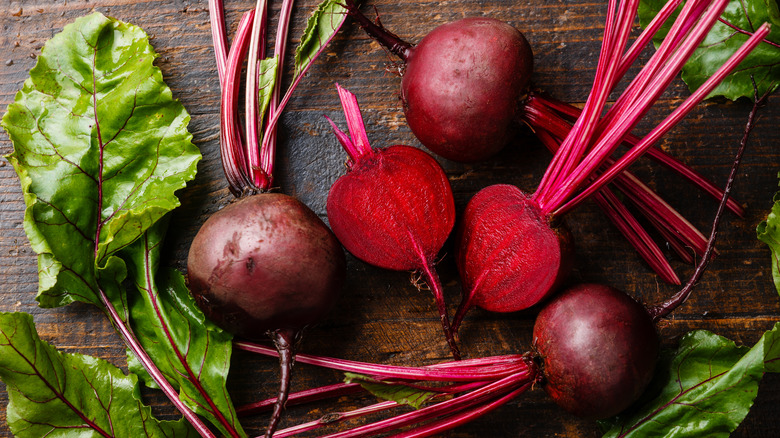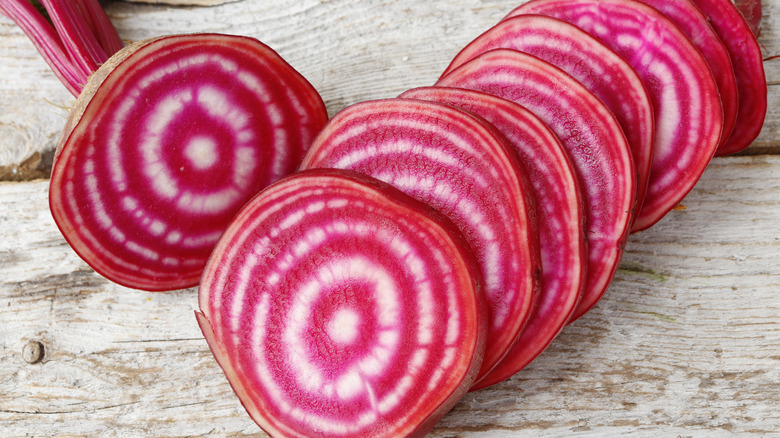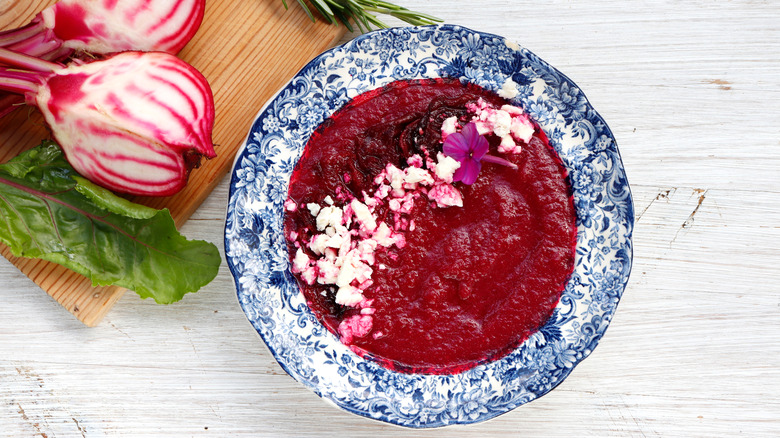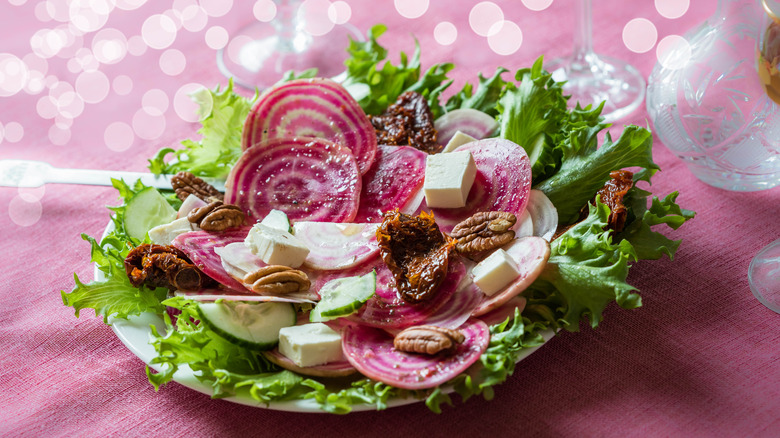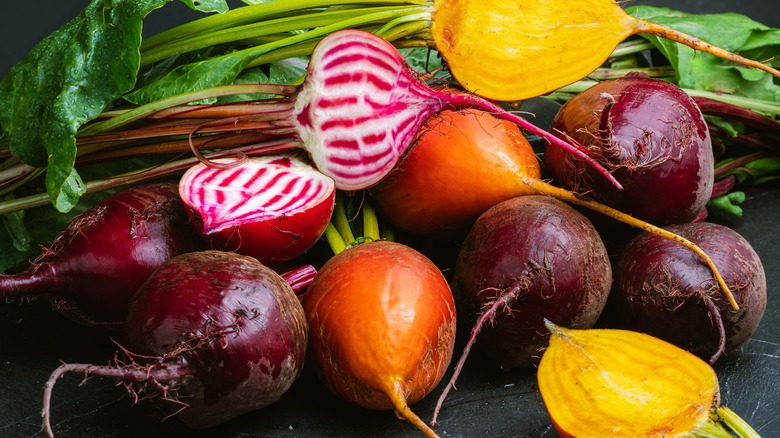Candy-Striped Beets Are More Than Just Their Vibrant Appearance
Beets have a reputation for being an acquired taste. In fact, they were voted one of America's least favorite vegetables in a 2019 survey, but with the right beets and the right recipe, you may actually enjoy these little pink root vegetables.
If you don't like beets, there may be a scientific reason why – they contain a polarizing chemical compound called geosmin, which is also released after a rainstorm. So oddly enough, if you love the smell of the air after it rains, you may take a liking to beets.
Beets thrive in salads with goat cheese and balsamic vinegar, blended into pasta sauces and hummus, and even in this vibrant beet-infused vodka cocktail. If you're still on the fence about these pink veggies, however, one variety may be able to tip the scale.
Chioggia beets, or candy-striped beets, are aptly named for being a little sweeter than other varieties – and they're a little prettier too. Besides tasting closer to candy than your average beet, the Chioggia variety is red and white striped, just like a candy cane. Let's find out where these veggies came from, and how you can use them in your kitchen.
What are Chioggia beets?
Chioggia beets go by quite a few names: candy-stripe beets, candy cane beets, and bull's eye beets to name a few. Their scientific name, however, is Beta vulgaris, which is the generic term used to encompass all types of beets. As beets fall in the amaranth family, they are a close relative of Swiss chard and mangold, a garden vegetable widely used as animal feed.
If you've ever seen a Chioggia beet, you'll know there's no other vegetable that looks quite like it. From the outside, these veggies are similar in size and shape to other beets — they're typically about two inches in diameter, smooth and round, and have vibrant, red-pink bulbs with leafy green stems. But once you cut into one of these beets, you'll notice their signature hot pink and white rings.
Based on their appearance, you may be wondering why these beets are primarily known as Chioggia instead of candy-stripe. They're named after the seaside Italian town of Chioggia, which is where they're from. Chioggia isn't as well-known as the nearby city of Venice, but they both have canals and old-world allure, which is why Chioggia is sometimes known as Little Venice. The beets didn't make it to the U.S. until the 1860s, but they caught on quickly once they did.
Chioggia beets vs. red beets
When you think of a beet, you're most likely thinking of a classic red beet. Because these beets fall under the Beta vulgaris umbrella, just like candy-stripe ones, the two are fairly similar. Red and Chioggia beets are round with a smooth, slightly hairy skin, and are attached to leafy greens that taste like chard.
And while they may have slight differences in flavor, the two can mostly be used interchangeably in cooking, although it's important to note that red beets are less sweet and a little firmer than their candy cane counterparts.
Within the beet world, however, there are a few key differences between red beets and Chioggias. While Chioggias are a vibrant red-pink on the outside and striped on the inside, red beets are darker, with a brownish-red skin and a maroon interior. Red beets are also known for bleeding their crimson juice all over the place during cooking, staining fingers and clothes alike — in fact, the amino acid tyrosine in these veggies inspired the color "beet-red," which is often used to describe someone's face turning red from embarrassment.
And while there is only one type of candy-striped beets, red beets can come in a few different varieties, including Detroit dark red, boltardy, red ace, and warrior. If you've ever had a red beet in the U.S., it was likely a red ace, the primary beet grown here.
What do Chioggia beets taste like?
Just like their candy cane nickname suggests, Chioggia beets are much sweeter than the rest, but still have earthy notes like other types of beets. In fact, these striped veggies have one of the most robust earthy flavors out of all the varieties of beets, which they get from their higher-than-average levels of the chemical geosmin.
While Chioggias are still moist and juicy, they're also crunchy when eaten raw. And if you're worried about getting bright red beet juice all over your clothes, you may want to go with the candy-stripe variety, as they bleed much less juice than other types.
Once you cook Chioggia beets, however, their texture and appearance completely change. All of those pretty pink-and-white striped rings fade away when the beets are boiled, steamed, or roasted, and the veggies instead become light pink throughout. Cooking candy-stripe beets also changes their texture from firm and crunchy to soft and a little mushy, although the sweet, earthy flavor stays intact.
How to cook with Chioggia beets
You can use Chioggia beets in pretty much any recipe that calls for red beets, but keep in mind that candy-striped beets will be sweeter and more earthy than what you may be used to. The best way to let these vibrant, uniquely patterned veggies shine is to use them raw in salads and grain bowls, or pair them with other veggies in side dishes.
They go particularly well with nuts like walnuts and almonds, cheeses like feta and goat, and herbs like basil and parsley – throw all these ingredients in a salad with some arugula, apple, and balsamic vinegar, and you've got a pretty and nutritious meal. You can also add them to grain bowls with quinoa, farro, or wild rice.
You can cook these beets too, of course, but keep in mind the stripes will disappear and you'll be left with a still-pretty pale pink veggie. When it comes to cooking beets, you have options — the veggies can be boiled, steamed, roasted, and even microwaved, although you'll want to clean the beets and peel their skin before eating them. To preserve their vibrant color when boiling, try adding a splash of lemon juice or white vinegar to the water.
Once cooked, Chioggia beets can be added to a stir-fry with other veggies, blended up into a beautiful pink pasta sauce, soup, or hummus, or even eaten plain.
Where to buy Chioggia beets
Chioggia beets may be the most available in their native country of Italy, particularly around Venice and the coastal town they were named after. But you may have some luck finding them in the U.S., as they're available year-round, although traditional candy-stripe beets are in season from February to June, and again in August and September.
It may be difficult to get your hands on this beet variety in major grocery store chains, although you may be able to track them down in health food stores like Whole Foods and Sprouts.
Beyond grocery stores, you may see Chioggia beets at your local farmers market or co-op. You can even buy them online if you don't have a co-op near you through services like FreshDirect. Or, if you have a green thumb, why not buy the seeds yourself and plant them in your backyard?
Before you buy a candy cane beet, check that it is smooth and hard without bruises or wet spots, and that it's not unusually large, as this can mean the beet has too much fiber. If you're buying the beets with the intention of eating the greens as well, make sure the stalks look fresh and aren't limp or mushy.
Nutritional information about Chioggia beets
Candy cane beets are undoubtedly sweet, but unlike actual candy, they're a highly nutritious food. They only have about 35 calories per beet, and Chioggias are a good source of calcium, vitamins A and C, fiber, and protein. One candy-stripe beet has a little less than six grams of sugar, but don't let that deter you — according to Medical News Today, research has shown that beets may lower the impact of diabetes.
And that's not the only health benefit they offer. Healthline shares that beets may help maintain healthy blood pressure, improve athletic performance by generating energy in your cells, combat inflammation, and support a healthy brain. But keep in mind that eating beets or drinking beetroot juice can lead to your urine or stool turning red or pink.
While this may be alarming, it shouldn't produce any negative health effects for most people — although those prone to getting kidney stones or UTIs should watch their intake, as consuming large amounts of beets may aggravate these conditions (via Verywell Fit).
Other varieties of beets
Chioggia beets are unique in their red-and-white striped insides, but they have a few siblings that are just as tasty, although not quite as eye-catching. While you may think of red or pink when you imagine a beet, did you know they can also be gold, yellow, or white? Yellow or golden beets are bred mostly for their distinct sunset-hued palette — the beets' insides are typically yellow, while the skin is usually pink or orange.
Sugar beets have even less in common with their red and Chioggia siblings. Unlike the latter varieties, it is possible to extract sugar from sugar beets, so companies use this type of sweetener in processed foods.
You've likely eaten sugar made from these beets without realizing it, as they're the second-highest source of sugar in the world, right after sugarcane. But if you saw a sugar beet, you may not be able to identify it as a beet right away, as these root vegetables are usually brown on the outside and white on the inside.
And while you probably won't find sugar beets at major grocery stores, you will likely see baby beets, which can be any variety of beet, just in a miniature size. They may be sold as a specialty item, but they typically taste the same as their larger beet brethren.
